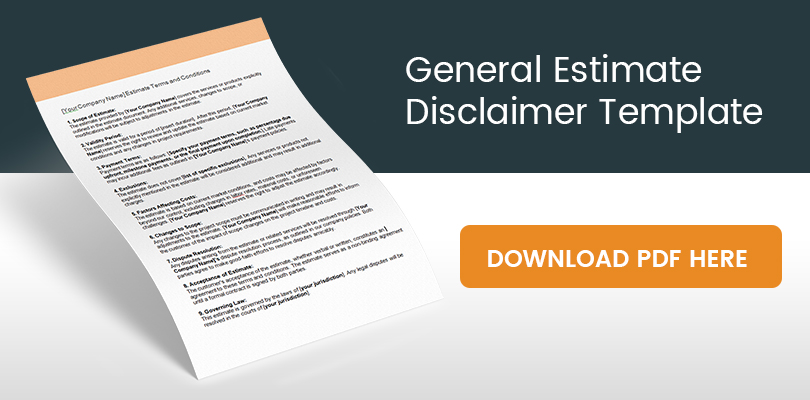In a perfect world, all your clients would pay you the moment you finish a job and for the full amount of the invoice. But unfortunately, that doesn’t always happen. That’s where including terms and conditions in your estimates can help speed up and clear up the estimate and payment process for you. And that is exactly why you should learn about estimate disclaimers. With these estimated terms and conditions, contractors can safeguard their businesses and ensure a consistent flow of revenue.
Create the perfect estimate, including proper terms and conditions, with Field Promax. Sign up now.
As a service provider, you are likely to provide the client with an estimate of how much it will cost to hire you to do the job. However, it is important to remember that this is an estimate, not the final price. A lot of unforeseen things could happen during the job, and you are not a fortune teller who can predict the future. So, you must come to an understanding with your customer and leave room to accommodate such changes in the final invoice. This is where estimate disclaimers come to your rescue. The terms and conditions set in the disclaimer lay out the responsibilities of both you and the client, including the services you’ll provide and how much they’ll cost. This helps to avoid client disputes in the future and sets expectations from the very beginning of your relationship.
Evidently, this is all very intricate. It does not just involve the technical aspects of the job; it also includes some legal issues. Therefore, before proceeding with the task of estimate terms and conditions, contractors should be fully aware of what it is and how it works. More importantly, they must understand what goes into a perfect estimate disclaimer.
In this blog, you will find answers to all your questions regarding estimate disclaimers. Read on to learn more about it and protect your business from the risk of getting sued by your customers in case of untoward events.
What is an Estimate Disclaimer?
An estimate disclaimer is a legal statement commonly included in estimates and contracts to define the terms and conditions associated with the provided cost estimates. This disclaimer serves as a protective measure for the party providing the estimate, often a business or service provider, by outlining the nature of the estimate and clarifying the expectations of the parties involved. The primary purpose of an estimate disclaimer is to mitigate misunderstandings and establish a clear understanding between the service provider and the client.
In the context of business transactions, an estimate disclaimer acts as a preemptive legal statement for estimate and contract. It typically communicates that the estimate is an approximation of anticipated costs based on the information available at the time of estimation. This acknowledgment is crucial because, in many cases, unforeseen factors or changes in project scope can impact the final costs.
By incorporating an estimate disclaimer into their documentation, businesses and service providers can establish transparency, manage client expectations, and reduce the risk of disputes related to cost variations or scope changes. This legal statement helps foster a clear and fair understanding between parties, contributing to a smoother and more legally sound contractual process.
Key Elements of an Estimate Disclaimer
- Non-Binding Nature
The disclaimer emphasizes that the estimate is non-binding and subject to change based on various factors, such as unforeseen circumstances or alterations to the project requirements.
- Limited Scope
It clarifies that the estimate covers only the specified services or items mentioned and may not encompass additional services or changes in scope that may arise during the project.
- Validity Period
Some estimate disclaimers include a stipulated validity period, indicating that the estimated costs are only valid for a specific timeframe. This helps account for fluctuations in market conditions or changes in project requirements over time.
- Terms of Payment
The disclaimer may include information about payment terms, specifying when and how payments should be made, as well as any applicable fees or penalties for late payments.
- Subject to Contract
It reinforces that the estimate is subject to the finalization of a formal contract. This emphasizes that the estimate is not a legally binding agreement but a preliminary step toward reaching a contractual arrangement.

Benefits of an Estimate Disclaimer
Now that you have a clear understanding of what an estimate disclaimer is, let’s have a look at its benefits. In other words, let’s find out how to estimate terms and conditions contractor disclaimer can help you safeguard your business from legal and financial risks.
- Mitigating Misunderstandings
Estimate disclaimers act as a preemptive measure to mitigate misunderstandings between businesses and their clients. By explicitly stating that the estimate is non-binding and subject to change, businesses set the expectation that the provided cost approximation is based on the information available at the time of estimation. This helps avoid disputes arising from clients expecting fixed costs in dynamic business environments.
- Flexibility in Project Changes
Business landscapes are inherently dynamic, and projects often change scope, requirements, or unforeseen circumstances. Estimate disclaimers empower businesses by indicating that the estimate is subject to alterations based on evolving project conditions. This flexibility is crucial in adapting to unexpected changes without jeopardizing the business’s financial well-being or straining client relationships.
- Protection Against Scope Creep
Scope creep, the gradual expansion of a project’s scope beyond its initial parameters, is a common challenge in various industries. Estimate disclaimers clearly define the limited scope covered by the estimate, protecting businesses from unintended and uncompensated work. This helps in avoiding disputes and ensures that any additional services or changes in scope are subject to negotiation and agreement.
- Validating Time-Sensitive Estimates
Many businesses operate in markets with fluctuating conditions, such as material costs or labor rates. Estimate disclaimers often include a validity period, indicating that the estimate is only valid for a specified timeframe. This protects businesses from being bound by outdated cost projections and allows for adjustments that account for changes in market conditions over time.
- Enhancing Legal Clarity
Including an estimate disclaimer contributes to the legal clarity of the business transaction. It reinforces that the estimate is not a legally binding agreement but a preliminary step toward the finalization of a formal contract. This distinction is crucial in legal contexts, providing a foundation for businesses to negotiate and finalize terms with confidence.
- Defining Payment Terms
Estimate disclaimers commonly include information about payment terms, specifying when and how payments should be made. This clarity reduces the likelihood of payment-related disputes and ensures that both parties are on the same page regarding the financial aspects of the transaction.
Steps to Writing an Estimate Disclaimer
Every business is unique, and no two sets of terms and conditions will be identical. The terms associated with a landscaping business will address different scenarios from those required by an HVAC service company, for example. Therefore, to take advantage of estimate terms and conditions, contractors must develop a thorough format and include the necessary components carefully. This ensures that customers understand what to expect from the estimate and agree to comply with the terms and conditions.
Here are some basic best practices you should follow when writing any estimate disclaimer:
- Introduction
Begin with a clear and concise introduction that explains the purpose of the disclaimer. For example: “This estimate disclaimer is provided to clarify the terms and conditions associated with the estimates provided by [Your Company Name].”
- Definition of Estimate
Define what an estimate is. Make it clear that an estimate is an approximation and not a guaranteed price. For instance: “an estimate is an approximate calculation of the likely cost, duration, or other relevant factors associated with a particular service or product.”
- Include Relevant Payment Data
Your estimate must include a price, general estimate terms, and some basic payment information. It’s significant to remember that your estimate’s pricing is “subject to change.” It will safeguard your small business from pricing changes. For instance, if you’re a small business owner and need to purchase lumber to finish a project, you have no control over the final price of lumber (which your estimate will consider). Additionally, you might want to note how any labor or price modifications will be billed. You can refer to such changes and fluctuating prices for direction if the task is more challenging than anticipated or the client’s requirements alter.
- Limitations of Estimates
Clearly state the limitations of the estimates. Mention that actual costs, timelines, or other factors may vary. For example: “Estimates provided by [Your Company Name] are based on available information at the time of estimation and are subject to change based on unforeseen circumstances or additional requirements.”
- Scope of Estimate
Specify the scope of the estimate. Clarify what is and isn’t included in the estimate. This helps set expectations for the customer. For instance: “This estimate covers [list of inclusions] and does not include [list of exclusions].”
- Factors Affecting Estimates
Outline the factors that can affect the accuracy of the estimate. This may include changes in market conditions, unforeseen challenges, or variations in project scope. For example: “Estimates may be affected by factors beyond our control, including but not limited to changes in market conditions, unforeseen challenges, or modifications to project specifications.”
- Communication of Changes
Explain how changes to the estimate will be communicated. This may involve notifying the customer promptly if there are any adjustments to the estimate. For instance: “In the event that the estimate needs to be adjusted, [Your Company Name] will communicate these changes to the customer as soon as possible.”
- Expiration of Estimates
Specify the validity period of the estimate. This could be a set number of days or weeks. Clarify that after the expiration date, the estimate may no longer be valid. For example: “This estimate is valid for a period of [insert duration]. After this period, [Your Company Name] reserves the right to review and adjust the estimate as necessary.”
- Dispute Resolution
Include a clause on dispute resolution. Outline the process that will be followed in the case of disagreements regarding the estimate. For instance: “Any disputes related to the estimate will be addressed through [Your Company Name]’s dispute resolution process as outlined in our [company policies/terms and conditions].”
- Legal Disclaimer
Conclude with a legal disclaimer stating that the estimate disclaimer is subject to the laws and regulations applicable in your jurisdiction.
- Review and Updates
State that the estimate disclaimer is subject to review and updates, and any changes will be communicated to customers. For example: “This estimate disclaimer is subject to periodic review, and [Your Company Name] reserves the right to update its terms. Any changes will be communicated to customers through [appropriate channels].”
- Additional details
Even though there isn’t a formal contract between you and your client, you should always present yourself professionally. The details listed below should be present in a well-designed estimate template:
- Company’s information:: Add your company’s information here to maintain a professional image and to provide contact information. For example, include details like your logo, address, phone number, email address, and other details you believe people might find valuable.
- Client info:: Make it obvious who the estimate is for in the client information. Include the company name, address, phone number, and email.
- Estimate number:: Similar to an invoice number, the estimated number makes it simple to track estimates and keeps you organized.
- Date:: This should be when you provide your client with the estimate, not when you first discussed the job.
- Project description:: The estimate should include a project description for the client to review. It aids in your ability to condense your understanding of the project and ensures that you and your client speak the same language.
- Terms and conditions: In your TC, you might specify the client’s payment method and mention that estimates are subject to modification.
- Signature
As long as they are a part of a contract, disclaimers are legally binding. The contract must be written and include detailed descriptions of all terms and disclaimers. Most importantly, the estimate disclaimer should be duly signed by both parties, i.e., the contractor and the customer, to be considered a legally binding contract. Add an area where the customer and you, as the business owner, can sign and say both parties agree to the terms of the estimate disclaimer.
Important Guidelines for Preparing an Estimate Disclaimer
There are a few rules to live by when thinking about what to write and how to lay everything out. If you follow these guidelines, you’ll be on the right track:
- In the estimate terms and conditions, contractors must make it clear that the estimate is subject to change. This may sound like an obvious thing to point out, but you want to spell it out clearly for your customers to avoid misunderstandings.
- Be specific about the different factors that will affect the final cost. That doesn’t always mean the cost will be higher for the customer either; there are occasions when the final cost is lower than the estimate.
- Indicate the estimate disclaimer is valid for a set period of time and outline that time frame (for example, 30 days) or list an expiry date for the estimate. This ensures there’s no confusion with the customer later on in the project.
- Confidentiality is key. Indicate that any information within the estimate disclaimer is confidential and won’t be shared outside of the business. This is to protect yourself from the customer potentially sharing details of the estimate without your permission. Both parties stay informed.
- Payment terms and conditions. Include any payment terms and acceptable payment methods (for example, electronic payment vs. offline payment methods), credit card charges, or other payment terms to avoid misunderstandings later.
- List your contact information so that the customer can reach you should they have any questions about the work or estimate.
- A little politeness goes a long way. As you email pricing disclaimer, don’t forget to thank the customer for their inquiry and say that you look forward to getting started on the job.
General Estimate Disclaimer Template
Industry-Specific Estimate Disclaimer Examples
Below is an example of the specific areas a plumbing job estimate disclaimer may cover:
- Clogged drains do not come under warranty
- Frozen pipes do not come under warranty
- Any customer-supplied parts are not covered under warranty.
Below is an example of the specific areas a cleaning business estimate disclaimer may cover:
- The customer will provide any finishing materials required
- The workspace will be clear of any fragile or personal belongings
- Weekends, bank holidays, and after 5 p.m. will be charged with an out-of-hours rate in mind, so pricing will differ.
Some service providers in the construction industry employ the following clauses:
- Electrical installations must comply with building regulations at the time the work is carried out
- All cables will be concealed if possible but if necessary, they will run in plain sight
- The customer must identify and mark all services above and below ground in relation to the work site, for example, all sewers, pipes, and drains.
Some service providers in the construction industry employ the following clauses:
- The contractor commits to supply all labor, materials, equipment, project requirements, supplies, supervision, and project management needed to finish the project.
- Any licenses required for the project must be obtained and maintained in good standing by the [owner or contractor].
- Within [X days] of the project’s completion, the contractor shall permit the owner to conduct a complete inspection and give the owner a list of any things that need to be finished or fixed.
Originally Published at:- FIELD PROMAX (Estimates templates)









